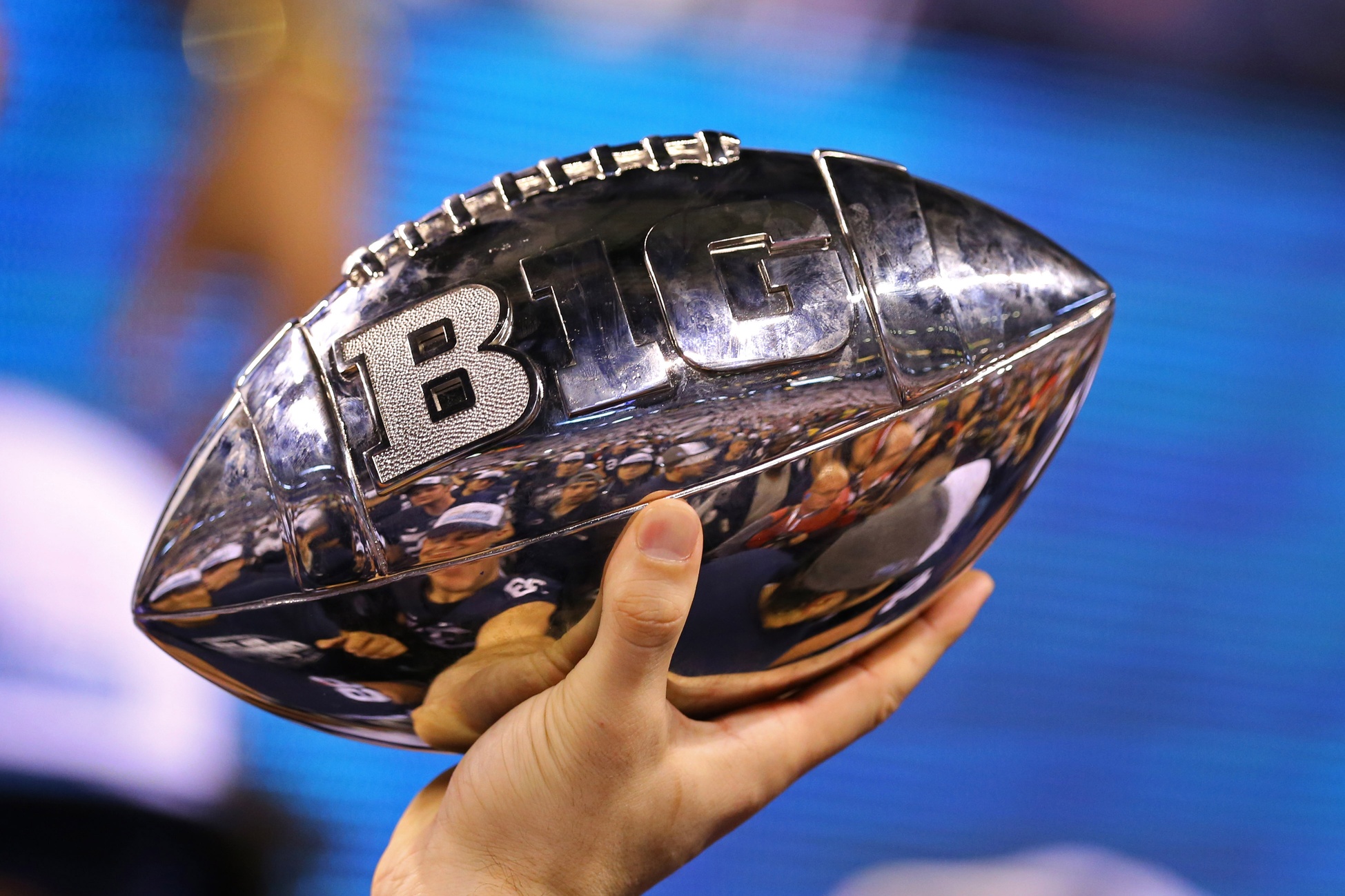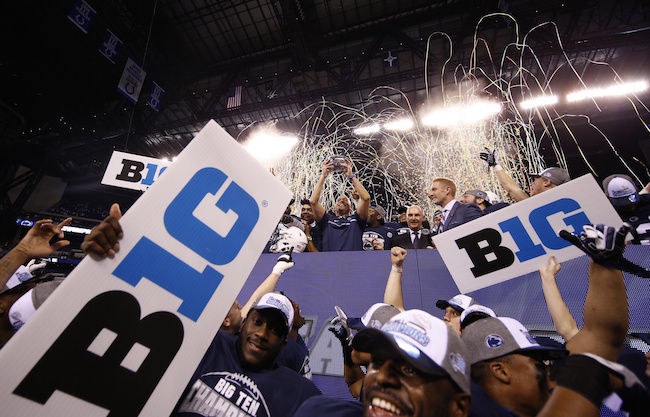Ad Disclosure

Identity of a champion: Defining the similarities of past B1G title winners
Everyone wants the secret formula.
Coaches can emphasize the cliché traits — convert third downs, win the turnover battle and control the line of scrimmage — but that doesn’t mean they’ll lead to a conference title.
What does lead to a conference title? More specific, what leads to a B1G title?
After all, every conference is different. A Big 12 team might be really stout against the run, but that doesn’t do them much good against Air Raid offenses that throw the ball 80 percent of the time.
A B1G team might be rock solid against the pass, but that won’t matter a ton come November when teams are running the ball 60 times because it’s 25 degrees in the Midwest.
So is there a championship identity? That is, are there statistical commonalities in past B1G Championship winners?
If you just thought about commenting “Yeah, every B1G champion scores more points than the other team,” go take a lap. You’re definitely the first person to use that joke.
But if you do want to dig deeper into what a “B1G Championship identity” might look like, sit back, relax and keep reading.
The point of this isn’t to say that every past B1G Championship winner is the same team. That would be silly. Nobody in their right mind would confuse 2016 Penn State with 2015 Michigan State.
But are there certain stats that matter more than others?
I decided to take a handful of stats that coaches seem to stress and try and see if there were was a correlation between past B1G Championship winners. Do all of them average 200 rushing yards per game? Are all of them ranked in the top 10 nationally in turnover margin?
Here the numbers I found for some of those common stats:
| CHAMP. SEASON STATS | 2011 UW | 2012 UW | 2013 MSU | 2014 OSU | 2015 MSU | 2016 PSU |
|---|---|---|---|---|---|---|
| Rushing yards per game | 236 | 236 | 174 | 265 | 151 | 172 |
| 1st/2nd team All-B1G QB? | Yes | No | Yes | Yes | Yes | Yes |
| FBS offense rank | 6 | 59 | 64 | 5 | 60 | 21 |
| FBS defense rank | 13 | 17 | 3 | 26 | 25 | 47 |
| FBS turnover margin rank | 4 | 48 | 10 | 32 | 4 | 64 |
| Second-half scoring differential | +163 | +55 | +140 | +147 | +32 | +199 |
| Record vs. AP top-10 teams | 1-1 | 0-1 | 2-0 | 3-0 | 3-1 | 2-2 |
| Time of possession share | 53.7% | 53.7% | 55.6% | 52.5% | 54.8% | 46.2% |
| Point differential in B1G play | +196 | +98 | +150 | +163 | +98 | +142 |
There are several takeaways from those numbers.
First of all, you’ll notice the 2012 Wisconsin team is a bit of an outlier in most of the categories. That, of course, was because that team was a measly 4-4 in conference play but it advanced to the B1G Championship because 12-0 Ohio State and 8-4 Penn State were banned from postseason play.
In other words, 2012 Wisconsin isn’t the best measure of our data. Perhaps that’s why that team was the only B1G champion NOT to have a first- or second-team All-B1G quarterback. Russell Wilson, Connor Cook, J.T. Barrett and Trace McSorley all had breakout years (Cook earned All-B1G twice) in leading their teams to conference titles.
Having an elite quarterback helps pave the road to Indy. Obviously.
The defensive numbers also stood out. Five of the six B1G champs — including 2012 Wisconsin — had defenses that finished in the top 21 percentile nationally. Penn State was the only group that didn’t, but the Lions allowed just 17.8 points per game in their eight-game winning streak that got them to the B1G Championship. That continued pace would’ve ranked in the top 10 in FBS.
The Lions were also the only team on that list that didn’t possess the ball at least 52.5 percent of the time. Maybe that happened because they had a guy that could do this:

But you don’t NEED a superstar tailback like Barkley to win a B1G Championship. Michigan State didn’t have a true feature back in 2015.
Speaking of those 2015 Spartans, they almost had the same identity as the aforementioned 2012 Wisconsin team. They both finished with a +98 point differential in conference play. They won conference games by an average of just 12.25 points.
More common among B1G champs were the teams that dominated in conference play. Wilson’s Badgers and OSU’s 2014 national title squad beat conference foes by an average of roughly three touchdowns. Teams that win a bunch of close games like 2015 MSU aren’t supposed to end up in Indianapolis. Teams that beat Purdue and Rutgers by a combined 10 points like 2015 MSU aren’t usually conference title contenders.
RELATED: Golden Nugget releases early odds for 2017 B1G Championship
But 2015 MSU shared one of the few true statistical commonalities among B1G champs. That team dominated the turnover battle. Finishing fourth in the nation in that metric was likely the difference in MSU earning a College Football Playoff bid and making the Sun Bowl.
Penn State was the only B1G champ — not including 2012 Wisconsin — that didn’t finish in the top 25 percentile in that category. But look a little closer and you’ll realize the Lions actually were +9 in turnover margin during that eight-game winning streak to close out the regular season.
If you’re keeping track, a true B1G champ usually has:
- all-conference quarterback
- defense in the top 21 percentile of FBS
- huge point advantage in conference play
- significant turnover advantage
There were other numbers worth looking at.
For example, third-down conversion percentage is usually considered an important factor, as is red-zone efficiency and penalty yards. There were some mixed results with that.
| CHAMP. SEASON STATS | 2011 UW | 2012 UW | 2013 MSU | 2014 OSU | 2015 MSU | 2016 PSU |
|---|---|---|---|---|---|---|
| FBS red-zone offense rank | 2 | 63 | 77 | 48 | 59 | 43 |
| FBS red-zone defense rank | 77 | 120 | 36 | 77 | 78 | 106 |
| FBS 3rd down conv. % offense rank | 1 | 94 | 37 | 3 | 10 | 117 |
| FBS 3rd down conv. % defense rank | 50 | 17 | 2 | 16 | 30 | 52 |
| FBS fewest penalty yards per game rank | 17 | 9 | 78 | 43 | 23 | 28 |
By looking at the table, it’s clear that red-zone efficiency is — for the most part — an overrated statistic. Championship teams do a lot of their scoring from outside of 20 yards. Certainly it helps, but it isn’t a deal-breaker.
Teams can also win B1G Championships without a high third-down conversion percentage. Penn State was among the bottom 12 teams in the country in that category last year. Teams like the Lions that have quick-strike ability don’t need long drives to score. That explained why they were the time of possession outlier.
The two biggest commonalities among B1G champs among those five statistics were third-down conversion defense and penalty yardage. Only 2013 Michigan State ranked in the latter half of FBS teams in either one of those categories.
RELATED: Four B1G teams make ESPN’s future power rankings
Championship teams don’t need to have top-10 defenses, but they need to be able to get off the field. Championship teams don’t have to be penalty free — one could argue that’s a bad thing — but that can’t be a major weakness. Championship teams don’t consistently give away yards and they have defenses that get off the field.
What crazy concepts!
There’s one other thing. This might come as a no-brainer, but it’s worth noting. Not including the 2012 Wisconsin team, past B1G champions were 32-1 at home. The only home loss by a B1G champion was when Ohio State fell to Virginia Tech in non-conference play in 2014. The Buckeyes then won out and claimed the first College Football Playoff National Championship.
It’s one thing to lose a tough road game against a solid opponent. Regular season losses are going to happen, especially in the nine-game conference format. But if a team gives away a home game, it probably isn’t a good sign.
So to recap, here are your most common characteristics of B1G champs:
- all-conference quarterback
- defense in the top 21 percentile of FBS
- huge point advantage in conference play
- significant turnover margin advantage
- above average third-down conversion defense
- minimal penalty yards per game
- run table at home
Seems simple enough, right?
Connor O'Gara is the senior national columnist for Saturday Tradition. He's a member of the Football Writers Association of America. After spending his entire life living in B1G country, he moved to the South in 2015.
